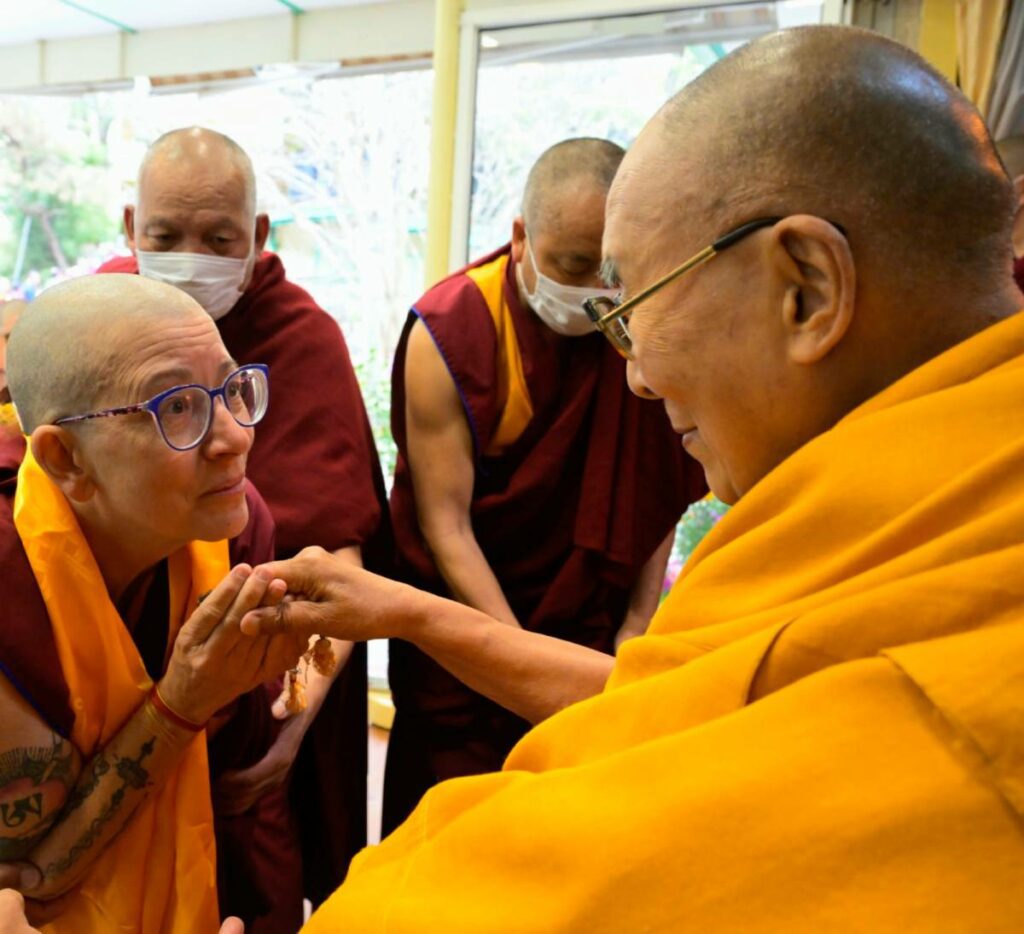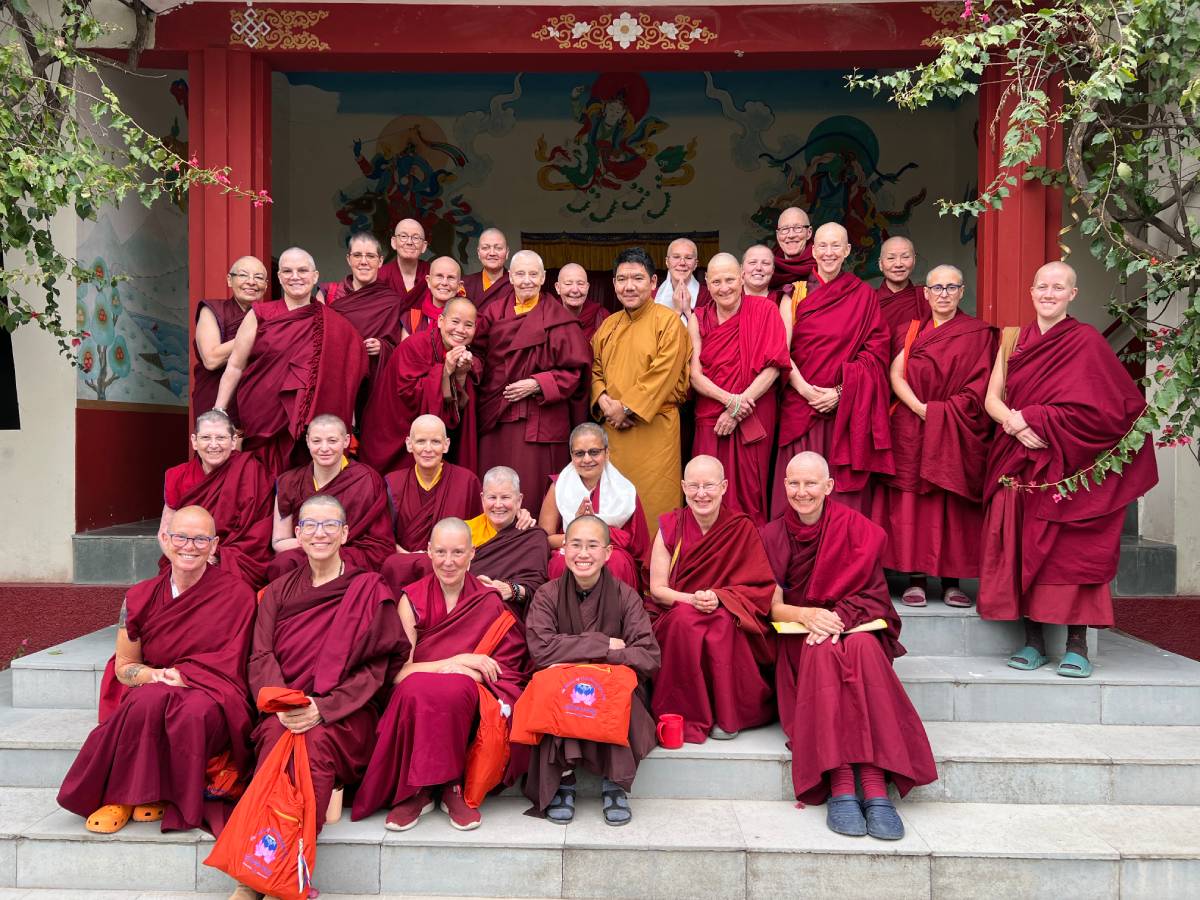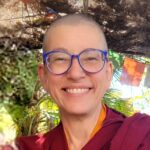Nestled in the Himalayan foothills of Sidhpur village, just outside Dharamsala, India, Thosamling Nunnery is a fifteen-minute walk from the nearest dirt road. The narrow path from the village winds through acres of achingly green, low-growing wheat cultivated in paddies like rice.
We reached the village at 2:00 a.m. after a harrowing 16-hour bus ride from New Delhi. An early March thunderstorm raged outside. There were 11 of us, many in our sixties or older, and hiking through wheat paddies in the middle of a deluge seemed daunting to say the least. Three at a time, we followed our guides’ bobbing headlamps along the path, our hand luggage bumping along behind. The wind, rain, and thunder were deafening.
Standing at last in Thosamling’s dining hall, soaked through, cold, and laughing, one of us said through chattering teeth, “Well, we know this Gathering must be important. That was like climbing the mountain to see the Guru!”
She was not wrong.
We were among the first of 37 non-Himalayan nuns (NHNs) to descend upon Thosamling in the early days of March. Representing 17 countries and all four lineages of Tibetan Buddhism, we’d come to participate in The Gathering, a three-week event created by the Alliance of Non-Himalayan Nuns (ANHN). “It’s very unique, us coming together like this, very, very rare.” said the trailblazing British nun Jetsunma Tenzin Palmo, who was both a participant and guide during the Gathering. “I don’t remember going to any conference or gathering where every single person was a non-Himalayan monastic.”
With a disrobing rate of up to 75% among non-Himalayan nuns, the timeliness and importance of this first-ever international Gathering was clear. We had gathered to identify the complex, sometimes daunting factors leading to that discouraging statistic, “to collaboratively develop solutions for the challenges encountered by many Non-Himalayan Nuns today” (ANHN), and to experience – some of us for the first time – the strength and support of monastic community.
Monastic Bardo
The Alliance of Non-Himalayan Nuns was founded in 2014. At the time, it was an initiative brought to life by Jetsunma Tenzin Palmo, Geshema Kelsang Wangmo, and Venerable Tenzin Sangmo. A fierce advocate for nuns and an inspiration to Buddhist women everywhere, Jetsunma was one of the first Westerners to take ordination as a Tibetan Buddhist nun. She famously spent twelve years in a secluded retreat in a Himalayan cave. Years later, she founded Dongyu Gatsal Ling, a beautiful nunnery for Himalayan nuns in India.
Non-Himalayan nuns, as defined by the ANHN, are ordained female monastics of any lineage of Tibetan Buddhism whose countries of origin are outside traditionally Tibetan Buddhist geographic areas (Tibet, Nepal, Bhutan, and North India). “Non-Himalayan Nuns in the Tibetan Buddhist tradition live in a kind of monastic bardo,” said Jetsunma, “They’re not supported by the laity or the lamas. There’s very little respect or appreciation that they’ve devoted their whole lives to the Dharma. They lose out on the pleasures of family life and worldly life and, at the same time, have very few of the joys of a true monastic life. They’re usually not living in a community. They’re by themselves. They can’t do the things which the lay people can do, but also they are not living a monastic life either.”

“The Himalayan nuns from Tibet and surrounds, on the whole, they’re doing okay now,” said Jetsunma in a 2022 interview with Yoga Journal Australia. “They are being supported and encouraged, they are in good nunneries, they are studying and so forth.” They are even supported to pursue distinguished Geshema or Khenmo degrees, which are the equivalent of a PhD. Non-Himalayan nuns, however, “continue to be overlooked,” noted Jetsunma. They experience a unique constellation of daunting financial, community, and personal challenges, which were some of the issues discussed during the Gathering.
Most NHNs reside in secular countries with an individualist rather than a communal, societal mindset. Thus, a cultural tradition of supporting spiritual or monastic communities is not present, and lay sanghas often innocently assume that non-Himalayan nuns receive financial support from their ordaining monasteries or lamas, which is not the case.
Some non-Himalayan nuns are forced by necessity to continue paid work in a lay setting and often must wear lay people’s clothing to do so – a heartbreaking compromise, as wearing robes is among our basic monastic vows.
Due to the lack of financial and communal support, many of us put off ordination for years—often into our fifties and sixties—so we can “afford” to ordain with a small pension or nest egg. Whatever our age at ordination, NHNs are often left to our own devices to figure out how to receive any sort of monastic training or financial support. “You get ordination,” said Jetsunma at the opening ceremony of the Gathering, “and the lama says, ‘Oh, wonderful, fantastic, great karma. Obviously, you must have been a monastic in your past life, and it’s very wonderful. Well done. Here is your Dharma name. Bye-bye.’ And that’s it…. For non-Himalayan nuns, what are you going to do? There is nowhere for us to go,” leaving a newly ordained non-Himalayan nun to fend for herself without any kind of support.
This may be in part due to the fact that when Buddhism came to the West, it was, for the first time, driven by and directed toward lay practitioners rather than monastics. “How can one live as a monastic within a situation which is totally or almost totally secular and still have a meaningful life as a monastic,” asked Jetsunma, “where often monastics find themselves alone, not even supported by having a community, and often considered quaint but irrelevant?”
A Place of Our Own
After two days of rain, we had our first sunny morning. Thosamling’s flowers, fruit trees, and cobblestone paths glistened; the Dhauladhar peaks behind were white with new snow. We’d finished morning prayers and filed out of the temple in ones and twos, some wandering to the dining hall or our rooms, others to the library.
Standing near the office, Venerable Tenzin Sangmo, abbess of the nunnery, watched the activity with intent blue eyes. Thosamling exists because of her. A quiet, formidable Dutch nun, Ven. Sangmo built the nunnery almost single-handedly and radiates the kind of humility, level-headedness, and sheer grit needed for such an undertaking.
“So many nuns!” she said softly. “It is such a dream. Really. The realization of a dream.”
Twenty-four years ago, when His Holiness the Dalai Lama said it would be beneficial for non-Himalayan nuns to have a nunnery of their own in Dharamsala, Ven. Sangmo got to work. Within three years, she’d assembled funding, purchased land, and begun construction. His Holiness fully supported her efforts from the beginning and personally consecrated the nunnery upon its completion.
Thosamling was the perfect home for the ANHN Gathering. For nearly a month, we lived, practiced, and meditated together and attended workshops, discussions, and lectures (live or via Zoom) from luminaries such as Ven. Thubten Chodron, Ven. Karma Lekshe Tsomo, Ven. Robina Courtin, Khenmo Drolma, Geshema Tenzin Lhadron, Lopon Pema Deki and others. We attended teachings at Dharamsala’s monasteries and centers and visited nunneries where we witnessed the fierce grace of our Himalayan sisters practicing debate.
“Before Thosamling,” said Ven. Sangmo, “non-Himalayan nuns had no place of their own. Now they have Thosamling. It is for them.”
The significance of Ven. Sangmo’s vision was driven home with sharp immediacy when one of our sisters became homeless during the first week of the Gathering. She’d recently moved to a new nunnery in Spain, managed by a lay center. She and one other nun worked hard to stabilize the nunnery, even investing their own money. She was excited to let other NHNs know about the beautiful nunnery by the sea and invite them all to live there. One morning, she received an unexpected text from the Spanish center’s management, informing her that they were closing the nunnery and repurposing the building, and she and the other nun had one month to move out.
One Table, Four Legs
From the beginning, the Buddha was committed to establishing a “Fourfold Sangha” of fully ordained monks, fully ordained nuns, lay men, and lay women. He said it was like the four legs of a table, making the Dharma very stable, and that as long as the fourfold Sangha endured, the Dharma would flourish. “The Buddha specifically emphasized the importance of the fourfold Sangha right from the start,” said Jetsunma. “That was his vision from the beginning, it wasn’t that nuns were forced on him. He had that vision and expressed it to Mara right after his enlightenment, a balanced sangha of monastics and lay people of both genders.”
The demographic of NHNs at the Gathering ran the gamut of ordination. Some nuns had been ordained for as little as two weeks, others had been ordained for many decades. Levels of ordination differed as well. Two nuns held Rabjungma junior novice ordination with eight vows. The majority of us held Getsulma novice ordination, with thirty-six vows. At the moment, this level is the highest ordination officially allowed for Tibetan Buddhist nuns.
However, a small handful of us were fully ordained Bhikshunis, holding 354 vows. These Bhikshunis had gone outside the Tibetan lineage to receive their full ordination in the Dharmagupta (non-Tibetan) Vinaya, traveling to Hong Kong or Taiwan to do so. Until recently, this method was the only way any Tibetan Buddhist nun could become fully ordained.
However, in 2022 His Holiness the Je Khenpo of Bhutan – head of the Central Monastic Body in Bhutan – with the blessing of the royal family of Bhutan, offered full Bhikshuni ordination to 142 nuns. Only one of them was non-Himalayan. She was present at the Gathering. Accordign to Jetsunma:
“This [was] the first time, that full ordination has been given to a group of nuns in the Tibetan tradition. Occasionally in Tibetan history some high lama gave it to one or two women close to him, such as his sister, but never in such a public event. The king, the queen mother and all the royal family [of Bhutan] requested the Je Khenpo to please give full ordination to nuns. We have spent the last thirty or fourty years talking about it; from His Holiness the Dalai Lama to the Karmapa, everybody talks about it. But this was the first time it was actually given, so it was a very auspicious occasion, and we [were] very joyful.”
Whatever our level of ordination, one question at the forefront of the Gathering became how to help the lay sangha understand the relevance and contribution of the monastic Sangha. “In the West, even in Dharma circles,” said Jetsunma, “they don’t understand the kind of life you are trying to live and how that differs from a very devoted lay life. What’s the difference? Why bother? So, what makes the crucial difference between a monastic and a lay person? And why is it, therefore, that we feel becoming a monastic was so meaningful for us?”
Most of us could not fully articulate why we’d wanted to ordain, we just knew we had to. Each of us described an inexplicable, fervent yearning, often present since childhood or from the moment we’d encountered the Buddha Dharma; an urgent calling to make use of our precious human lives for the benefit of all beings.
Several of us could point to specific life events that had given us a final push toward ordination — usually a profound experience of impermanence. One of us had survived a hostage situation. Another had been clinically dead and brought back. Another was a survivor of multiple cancers. And yet another saw the death of her husband, mother, father, and two dogs, all within a few months.
Signs and Superpowers
Before he became the Buddha, young prince Siddhartha saw four “signs” that roused in him the unconquerable desire to find a path out of samsara, that motivated him to leave palace life. These signs were a sick person, an old person, a dead body, and a dignified, peaceful renunciate. The first three signs, examples of samsara’s suffering, spurred the Buddha-to-be to find the end of suffering. But the fourth sign, the renunciate, was like a finger pointing at the moon, indicating the path.
Most of our Himalayan sisters ordain at a very young age, sometimes four or five. But NHNs ordain as adults and possess a great depth of sincere renunciation rooted in life experience. “You actually know what you’re renouncing,” said Jetsunma, “as the Buddha did…. You have experienced everything which is said to be what makes life meaningful and recognized how meaningless it is. That makes our renunciation strong. Because we know. We know from genuine experience that that doesn’t work. That there must be something more to life, and the dharma provides the answer. That’s our strength.”
This, we came to realize, is why non-Himalayan nuns matter in the modern world, particularly in the West. We are that fourth sign. With our lives completely devoted to the study, practice and embodiment of Dharma, we can be that inspiration for people suffering in cultures consumed by materialism, greed and imbalance, showing them through mere presence, a path of peace, compassion, dignity and joy.
Venerable Tenzin Dasel, the tireless organizer of the Gathering, said:
The unique feature of non-Himalayan Buddhist Nuns is that we came into the vows and robes as mature women, not young girls who started in the nunnery system from an early age. We have life experiences that are very beneficial and relate with the experiences lay people face living in the world beyond the nunnery walls.
An immensely diverse and talented group of women, we each possessed a wealth of skills, devotion, and determination. We came from a range of cultures, personal backgrounds, Dharma experience, and lineages. We’d received years of training and education in Dharma and worldly institutions, colleges, and universities.
Ven. Dasel continues:
We come from all walks of life: professionals, some with advanced degrees, nurses, artists, scientists, highly trained financiers, interior designers, professors, teachers, florists, mothers, grandmothers even!…In short, we can listen to, and empathize with, diverse experiences that people find themselves in. And while we cannot remove all the confusion, we can lean in with compassion and wisdom.
We began referring to our skills and experiences as superpowers and to formulate methods for bringing them onto the path for the benefit of non-Himalayan nuns, the Dharma, and all beings. We had great, inspiring role models in Venerable Sangmo, Jetsunma Tenzin Palmo, and the many pioneering nuns we’d spoken with during our workshops. We began to build our own support structures to bolster and steady each other and to spread the word among our lay brothers and sisters.
Radiance

Midway through the Gathering, each of us received a blessing from His Holiness the Dalai Lama — a profound and, for some, life-altering event.
On a sunny afternoon shortly thereafter, we sat in Thosamling’s courtyard, sipping chai. We had been, for several days, playfully trying to come up with a collective noun for a group of nuns – like “pride” of lions or “flock” of birds.
On that afternoon, feeling filled with the blessings of His Holiness, we settled at last on “radiance.”
A radiance of nuns.
The phrase rolled off our lips and made each of us smile.
Our essence and our heart-calling, our path as non-Himalayan nuns, is to radiate the loving kindness, compassion, and peace of the Dharma while living in cultures desperately in need of it, to dedicate every single moment of our lives, every breath, and every molecule in our bodies to this luminous monastic calling, this strong and devoted sisterhood.

